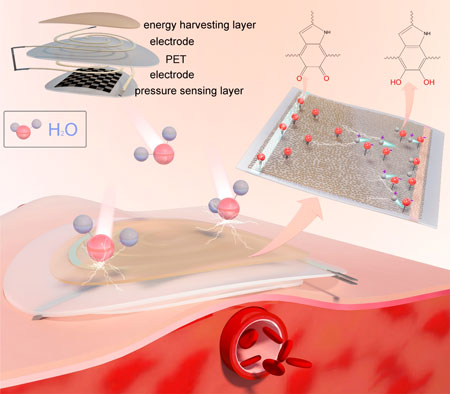| Aug 12, 2019 | |
Moisture-powered, multifunctional flexible sensing systems |
|
| (Nanowerk Spotlight) As flexible, wearable electronics move into the mainstream, the question of how to power these devices becomes a key issue. Connecting ultrathin, almost skin-like electronics and sensors with bulky, conventional batteries defeats the purpose. The ideal solution are self-powered devices that contain a built-in power generation capability that does not rely on external sources such as batteries or supercapacitors. | |
| To that end, a growing number of research groups around the world are exploring the fabrication of nano-sized power generators with triboelectric, thermoelectric or piezoelectric properties, allowing these devices to convert mechanical energy into electricity (read more in our previous Nanowerk Spotlight: Nanotechnology for self-powered systems). | |
| In addition to mechanical energy harvesting technologies, chemical potential energy, which widely exists in spontaneous diffusion processes such as ion or moisture diffusion, is a promising power source for self-powered wearable electronics systems. In a previous Nanowerk Spotlight (Moisture-powered electronics) we reported on a moisture-driven electrical generator based on the diffusive flow of water in titanium dioxide nanowire networks. | |
| Researchers in China have now demonstrated the feasibility of an environmental moisture-induced, self-powered wearable multifunctional sensing system with the ability to detect both humidity and pressure. They reported their findings in Nano Letters ("Moisture-Driven Power Generation for Multifunctional Flexible Sensing Systems"). | |
| "To effectively capture chemical potential energy in the environment, we first constructed a polydopamine (PDA) film with widely distributed micropores, which not only largely accelerates moisture capture but also facilitates ion transportation," Professor Ting Zhang from the Suzhou Institute of Nano-tech and Nano-bionics, Chinese Academy of Sciences tells Nanowerk. "By endowing this PDA layer with a hydroxy group gradient (termed g-PDA) via electrochemical reduction and oxidation on the electrodes, the captured moisture can trigger an ion concentration gradient which results in a high open-circuit voltage of 0.52 V combined with a power density of 0.246 mW cm-2." | |
| The team, led by Zhang, demonstrated a self-powered wearable sensing system by integrating a flexible micropatterned pressure-sensitive film on PET as the pressure sensor and attached it onto the back of a PDA power generator. | |
 |
|
| Schematic of the self-powered wearable multifunctional sensing system based on effective moisture-enabled electricity generation for energy harvesting and human physiological behavior (pulse) detection. (Reprinted with permission by American Chemical Society). | |
| The researchers prepared a typical device by directly spray printing g-PDA functional ink onto a PET substrate with two spiral silver electrodes. Rapid evaporation of the water solvent during the print process leads to widely distributed micropores (with an average diameter of about 1 µm) on the PDA film. These pores are critical for the device's performance as they allow access for film swelling with water vapor and subsequent ionization. | |
| In order to investigate the device's response to moisture, the team fabricated devices of various PDA-layer thickness. The best-performing device with a 240 nm-thick PDA layer has a response time of 0.15 seconds and recovery time 0.25 seconds, which are faster than those of devices with a thickness over 240 nm because it takes longer for water molecules to diffuse in thicker film. However, when the film is thinner than 240 nm, the ion density decreases and the ionic resistance increases compared with devices with a thicker PDA film. | |
| Finally, to complete the system, a flexible PDMS pressure-sensitive film with an integrated network of single-wall carbon nanotubes (SWCNTs) is attached to the g-PDA film. | |
| "Our pressure sensor exhibits a highly reproducible response and low hysteresis, making it applicable for dynamic behavior monitoring," Zhang points out. "The pressure sensor is also stable under different humidity conditions, because the sensitive film (SWCNTs/PDMS film), assembled by sealant onto PET substrate with electrodes, is isolated from the ambient moisture." | |
 |
|
| Configuration of the pressure sensor in the self-powered multifunctional sensing system. (a) Schematic of the prepared sensing system. (b) Top and (c) cross-sectional SEM images of the patterned PDMS-coated SWCNTs. (Reprinted with permission by American Chemical Society). | |
| To demonstrate the feasibility of this moisture-induced self-powered wearable multifunctional sensing system, the team placed it over the radial artery of the wrist to show it can provide real-time monitoring of human physiological signals (for instance pulse) without external energy supply. | |
| "It is very interesting that, when the system is in ambient humidity, there is no obvious signal from the system," notes Zhang. "However, once exposed to moisture by artificial exhalation or pneumatic equipment, the system can work immediately and provide high-resolution wrist pulse waveform. A regular repeatable 72 beat per minute pulse demonstrates that our moisture-induced self-powered sensing system can maintain a continuous power supply and sensitive pressure detection." | |
| The team's results prove that this moisture-powered sensor can stably and sensitively realize real-time human physiological signal detection. It potentially can also be applied in other areas such as wearable electronics, digital health monitoring, human-machine interface, electronic skins for robotics, or sensors for environmental monitoring. | |
| "We are now working on further optimizing device performance to achieve more stable and sustainable flexible power generators," Zhang concludes. "And based on that, we'll construct a multifunctional flexible sensing system – integrated with energy, sensing, wireless signal transmission and other parts – with new materials and device configurations." | |
 By
Michael
Berger
– Michael is author of three books by the Royal Society of Chemistry:
Nano-Society: Pushing the Boundaries of Technology,
Nanotechnology: The Future is Tiny, and
Nanoengineering: The Skills and Tools Making Technology Invisible
Copyright ©
Nanowerk LLC
By
Michael
Berger
– Michael is author of three books by the Royal Society of Chemistry:
Nano-Society: Pushing the Boundaries of Technology,
Nanotechnology: The Future is Tiny, and
Nanoengineering: The Skills and Tools Making Technology Invisible
Copyright ©
Nanowerk LLC
|
|
|
Become a Spotlight guest author! Join our large and growing group of guest contributors. Have you just published a scientific paper or have other exciting developments to share with the nanotechnology community? Here is how to publish on nanowerk.com. |
|
